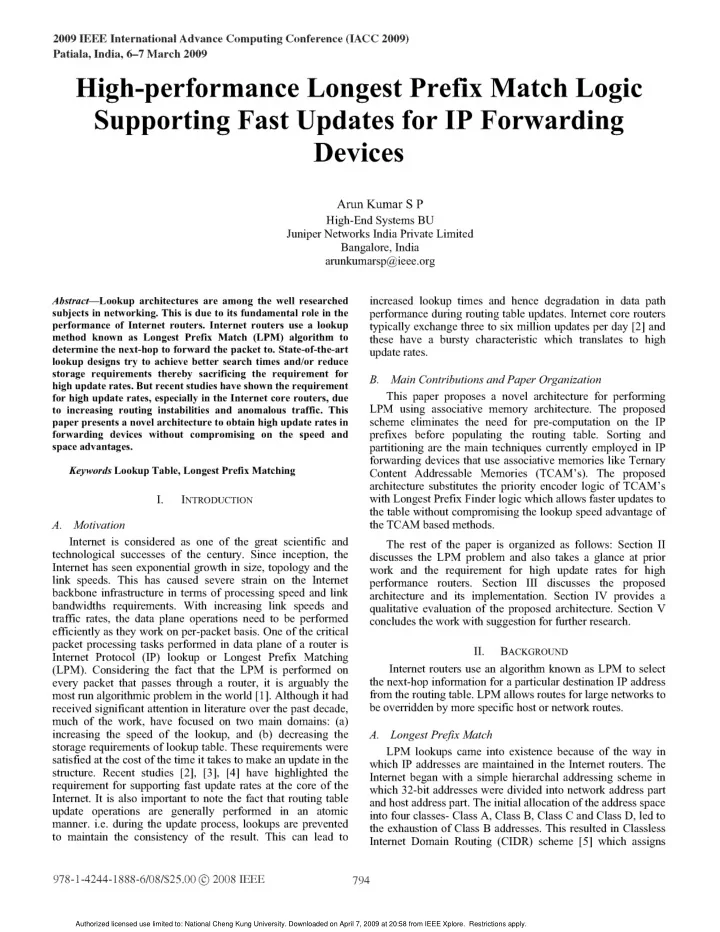

2009 IEEE International Advance Computing Conference (IACC 2009) Patiala, India, 6-7 March 2009 High-performance Longest Prefix Match Logic Supporting Fast Updates for IP Forwarding Devices Arun Kumar S P High-End Systems BU Juniper Networks India Private Limited Bangalore, India arunkumarsp@ieee.org Abstract-Lookup architectures are among the well researched increased lookup times and hence degradation in data path subjects in networking. This is due to its fundamental role in the performance during routing table updates. Internet core routers performance of Internet routers. Internet routers use a lookup typically exchange three to six million updates per day [2] and method known as Longest Prefix Match (LPM) algorithm to these have a bursty characteristic which translates to high determine the next-hop to forward the packet to. State-of-the-art update rates. lookup designs try to achieve better search times and/or reduce storage requirements thereby sacrificing the requirement for Main Contributions and Paper Organization B high update rates. But recent studies have shown the requirement This paper proposes a novel architecture for performing for high update rates, especially in the Internet core routers, due LPM using associative memory architecture. The proposed to increasing routing instabilities and anomalous traffic. This scheme eliminates the need for pre-computation on the IP paper presents a novel architecture to obtain high update rates in prefixes before populating the routing forwarding devices without compromising on the speed and table. Sorting and space advantages. partitioning are the main techniques currently employed in IP forwarding devices that use associative memories like Ternary Keywords Lookup Table, Longest Prefix Matching Content Addressable Memories (TCAM's). The proposed architecture substitutes the priority encoder logic of TCAM's with Longest Prefix Finder logic which allows faster updates to I. INTRODUCTION the table without compromising the lookup speed advantage of A. Motivation the TCAM based methods. Internet is considered as one of the great scientific and The rest of the paper is organized as follows: Section II technological successes of the century. Since inception, the discusses the LPM problem and also takes a glance at prior Internet has seen exponential growth in size, topology and the work and the requirement for high update rates for high link speeds. This has caused severe strain on the Internet performance routers. Section III discusses the proposed backbone infrastructure in terms of processing speed and link architecture and its implementation. Section IV provides a bandwidths requirements. With increasing link speeds and qualitative evaluation of the proposed architecture. Section V traffic rates, the data plane operations need to be performed concludes the work with suggestion for further research. efficiently as they work on per-packet basis. One of the critical packet processing tasks performed in data plane of a router is or Longest Prefix Matching Internet Protocol (IP) lookup II. BACKGROUND Internet routers use an algorithm known as LPM to select (LPM). Considering the fact that the LPM is performed on the next-hop information for a particular destination IP address every packet that passes through a router, it is arguably the from the routing table. LPM allows routes for large networks to most run algorithmic problem in the world [1]. Although it had be overridden by more specific host or network routes. received significant attention in literature over the past decade, much of the work, have focused on two main domains: (a) increasing the speed of the lookup, and (b) decreasing the A. Longest Prefix Match storage requirements of lookup table. These requirements were LPM lookups came into existence because of the way in satisfied at the cost of the time it takes to make an update in the which IP addresses are maintained in the Internet routers. The [4] have highlighted the structure. Recent studies [2], [3], Internet began with a simple hierarchal addressing scheme in requirement for supporting fast update rates at the core of the which 32-bit addresses were divided into network address part Internet. It iS also important to note the fact that routing table and host address part. The initial allocation of the address space in an atomic update operations are generally performed into four classes- Class A, Class B, Class C and Class D, led to manner. i.e. during the update process, lookups are prevented the exhaustion of Class B addresses. This resulted in Classless to maintain the consistency of the result. This can lead to Internet Domain Routing (CIDR) scheme [5] which assigns 978-1T-4244- 1888-6/08/f$25.00 Q 2008 IEEE 794 Authorized licensed use limited to: National Cheng Kung University. Downloaded on April 7, 2009 at 20:58 from IEEE Xplore. Restrictions apply.
Recommend
More recommend